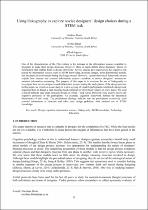 ResearchSpace
ResearchSpace
Using linkography to explore novice designers’ design choices during a STEM task
JavaScript is disabled for your browser. Some features of this site may not work without it.
- ResearchSpace
- →
- Research Publications/Outputs
- →
- Conference Publications
- →
- View Item
| dc.contributor.author |
Blom, N

|
|
| dc.contributor.author |
Haupt, G

|
|
| dc.contributor.author |
Bogaers, Alfred EJ

|
|
| dc.date.accessioned | 2018-10-23T12:40:59Z | |
| dc.date.available | 2018-10-23T12:40:59Z | |
| dc.date.issued | 2018-06 | |
| dc.identifier.citation | Blom, N., Haupt, G. and Bogaers, A.E.J. 2018. Using linkography to explore novice designers’ design choices during a STEM task. 36th International Pupils’ Attitudes towards Technology Conference, Athlone Institute of Technology, Co. Westmeath, Ireland, 18-21 June 2018 | en_US |
| dc.identifier.isbn | 978-1-5272-2507-7 | |
| dc.identifier.isbn | 978-1-5272-2508-4 | |
| dc.identifier.uri | http://terg.ie/index.php/patt36-proceedings/ | |
| dc.identifier.uri | http://hdl.handle.net/10204/10491 | |
| dc.description | Paper presented at the 36th International Pupils’ Attitudes towards Technology Conference, Athlone Institute of Technology, Co. Westmeath, Ireland, 18-21 June 2018 | en_US |
| dc.description.abstract | One of the characteristics of the 21st century is the increase in the information sources available to designers to make their design decisions. However, there is much debate about designers' choice of information that enables them to design effectively. Several studies have reported on the cognitive role played by information sources such as STEM knowledge, sketches, images, three-dimensional models, and the physical environment during the design process. However, current theoretical frameworks do not explain how internal and external information sources contribute to novice designers' moment-to-moment information processing. The purpose of this paper is to examine the use of linkography to investigate how novice designers used information sources during the early phases of the design process. In this paper, we report on a case study in which a group of Grade 8 participants completed a design task requiring them to design a heat retaining food container for street food vendors at a taxi depot. We used a mixed methods case study research design, in which Think-Aloud Protocols were used to access the cognitive processes of the participants. An extended cognition framework formed the theoretical foundations of this study. The preliminary findings indicate that the participants extensively used external information to structure and solve their design problems, with minimal use of STEM knowledge. | en_US |
| dc.language.iso | en | en_US |
| dc.relation.ispartofseries | Worklist;21445 | |
| dc.subject | Design cognition | en_US |
| dc.subject | Information sources | en_US |
| dc.subject | Linkography | en_US |
| dc.subject | STEM knowledge | en_US |
| dc.subject | Technology Education | en_US |
| dc.title | Using linkography to explore novice designers’ design choices during a STEM task | en_US |
| dc.type | Conference Presentation | en_US |
| dc.identifier.apacitation | Blom, N., Haupt, G., & Bogaers, A. E. (2018). Using linkography to explore novice designers’ design choices during a STEM task. http://hdl.handle.net/10204/10491 | en_ZA |
| dc.identifier.chicagocitation | Blom, N, G Haupt, and Alfred EJ Bogaers. "Using linkography to explore novice designers’ design choices during a STEM task." (2018): http://hdl.handle.net/10204/10491 | en_ZA |
| dc.identifier.vancouvercitation | Blom N, Haupt G, Bogaers AE, Using linkography to explore novice designers’ design choices during a STEM task; 2018. http://hdl.handle.net/10204/10491 . | en_ZA |
| dc.identifier.ris | TY - Conference Presentation AU - Blom, N AU - Haupt, G AU - Bogaers, Alfred EJ AB - One of the characteristics of the 21st century is the increase in the information sources available to designers to make their design decisions. However, there is much debate about designers' choice of information that enables them to design effectively. Several studies have reported on the cognitive role played by information sources such as STEM knowledge, sketches, images, three-dimensional models, and the physical environment during the design process. However, current theoretical frameworks do not explain how internal and external information sources contribute to novice designers' moment-to-moment information processing. The purpose of this paper is to examine the use of linkography to investigate how novice designers used information sources during the early phases of the design process. In this paper, we report on a case study in which a group of Grade 8 participants completed a design task requiring them to design a heat retaining food container for street food vendors at a taxi depot. We used a mixed methods case study research design, in which Think-Aloud Protocols were used to access the cognitive processes of the participants. An extended cognition framework formed the theoretical foundations of this study. The preliminary findings indicate that the participants extensively used external information to structure and solve their design problems, with minimal use of STEM knowledge. DA - 2018-06 DB - ResearchSpace DP - CSIR KW - Design cognition KW - Information sources KW - Linkography KW - STEM knowledge KW - Technology Education LK - https://researchspace.csir.co.za PY - 2018 SM - 978-1-5272-2507-7 SM - 978-1-5272-2508-4 T1 - Using linkography to explore novice designers’ design choices during a STEM task TI - Using linkography to explore novice designers’ design choices during a STEM task UR - http://hdl.handle.net/10204/10491 ER - | en_ZA |





